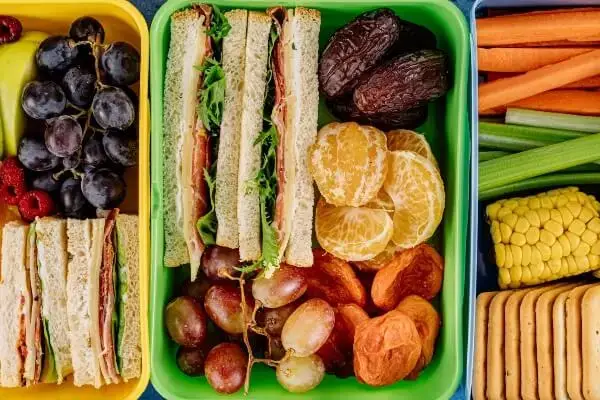Food-in-Schools Policy – How to Maintain High Standards
Pexels Licence – Antoni Shkraba
With a shared food-in-school policy, every interested party is aware of their responsibilities regarding food safety. Parents, teachers, students and governors can consult the policy and learn how the school promotes healthy living.
Writing a food-in-schools policy is simple that prioritises collective feedback and engagement is simple. The seven-step process in this guide allows you to prepare your students for a full, active lifestyle.
Why You Should Have a Food-in-Schools Policy
Creating a food-in-schools policy benefits the school, its staff, parents and, most importantly, students. A defined framework with goals:
- Establishes working relationships between school management, staff and parents
- Promotes healthier options and lifestyles
- Ensures consistent messaging regarding food and drink throughout the school
- Maintains equality of opportunity and access throughout the school
How to Create a Food Policy
When writing and implementing a food policy, you should allow every stakeholder to express their interests, aims and concerns. That way, everyone can buy into the final comprehensive food guidelines.
Here is a simple process to follow:
1. Identify Your Priorities and Messaging
Having a universal message is one of the fundamental benefits of the policy. Start by determining its goals and aims in line with your priorities. Maintain these ideas throughout the creation process.
Then, you should consult governors, senior management, and staff to understand their concerns and needs. Build an active forum with representatives from each body to discuss the initial plans thoroughly.
2. Audit the Current Presence and Usage of Food
You need a clear image of your current position regarding food to decide how to develop it. Break down any parts of the curriculum and extracurricular activities regarding nutrition and health and your lunch and snack provisions.
Then, create a ranking system to identify the crucial areas of improvement. Categorise them into groups such as ‘Good’, ‘Could Improve’ and ‘Poor’. These rankings allow you to implement the necessary targets and processes, starting with the highest priorities.
3. Draft a Policy
Once you have set goals and ranked the areas to improve, you can write an initial draft of the policy. Be clear and define your terms throughout so that anyone can easily understand your aims, objectives and evaluation criteria.
Remember to include the exact duties of everyone involved in the policy; it allows you to monitor performance and identify causes when things go wrong.
Specify:
- The introduction of the policy, including any dates, reviews, rights and where to find the policy
- Its aims and priorities
- The measurable objectives
- How will you meet these objectives?
- How will you evaluate the results?
4. Collect Feedback on the Draft
This step is pivotal. Everyone involved in the policy should have the opportunity to give feedback on the initial draft, including staff, caterers, students, parents, governors and senior management. That way, they can express their concerns.
Firstly, make the initial draft available for anyone to see. Then, create a questionnaire that addresses your primary concerns for targeted feedback and provides space for additional comments. You need to advertise the questionnaire and set a deadline for feedback so that people know to give their opinions.
Don’t forget to ask for both positive and negative comments. It will allow you to emphasise the elements of the policy that people like and adapt those they dislike during the updating process.
5. Update the Draft
After gathering everyone’s comments, you should discuss their feedback and opinions. Ask yourself, does the school have enough resources to implement the policy? Is there sufficient enthusiasm and support to justify increasing budgets and changing focuses?
After agreeing upon a set of amendments, adjust the initial draft. Finally, you will likely need the board of governors and the senior management team to sign off on the policy.
6. Spread Awareness
Before implementing the policy, you need to raise awareness of it so that everyone understands its requirements. Informational flyers, emails and posters are ideal.
Every audience is different; a graphic that parents understand easily may not resonate with pupils or staff. You should also translate the policy for people of various backgrounds or those with impairments. Then, create diverse materials with consistent messaging to cater to all these groups.
7. Implement the Policy
Now you are ready to launch. Delegate key responsibilities between teams and stakeholders and keep everyone informed on the progress. You should be able to pinpoint each individual’s obligations and actions.
Remember to evaluate and update your policy. There will likely be unforeseen problems that need resolving and future changes to stay on top of.
The Ideal Standard for a School Lunch
Lunch is a crucial element of a food-in-schools policy; we all know the importance of a balanced diet. Schools should provide adequate, healthy food for their students to maintain their energy throughout the day and support their growth.
Here are the major food groups and some serving recommendations and requirements:
Starch
Starchy carbohydrates provide energy to fuel students throughout their day and boost their concentration. Therefore, they have a direct impact on their education. You should provide three or more different starchy foods each week and try whole grain offerings for additional fibre. Consider offering:
- Potatoes
- Bread – must be available daily
- Pasta
- Rice
- Malt loaf
- Fruit bread
- Porridge
- High-fibre, low-sugar cereals
However, you should not serve starchy foods fried in oil or fat more than two days a week.
Fruit and Vegetables
All the food outlets in a school should offer fruit and vegetables to provide essential vitamins and nutrients. Children should have at least one portion of fruit daily and one portion of vegetables or salad with their lunch. In a week, they should receive at least three different fruits and three different vegetables.
Dairy
Children should receive a portion of dairy each day as an essential source of protein, calcium, riboflavin and vitamin A. On top of this, schools must provide low-fat milk at least once a day and can offer low-fat natural yoghurt or fromage frais with fruit to sweeten if necessary.
Protein
With amino acids that support muscle growth and iron and zinc, protein is vital. Schools should provide a portion of protein each day and meat or poultry on three days of the week. For essential Omega-3, offer oily fish once every three weeks.
Remember that many students have dietary requirements regarding protein due to their culture, lifestyle or religious beliefs. You must cater to those needs.
Consider mixing meat products with other foods to offer complete meals. You could serve:
- Sandwiches and wraps
- Muffin fillings and toast toppings
- Omelettes
- Frittatas
- Spanish Omelettes
- Tortillas
- Burritos
- Quesadillas
- Fajitas
High Fat, Sugar and Salt Foods
Foods that contain large amounts of fat, sugar or salt have been shown to lead to health complications such as obesity, so must be limited in schools. You should not serve:
- Over two portions of deep-fried, breaded or battered food in a week
- More than two portions of food with pastry in a week
- Snacks, except nuts, seeds and vegetables
- Breadsticks or savoury crackers
- Confectionary, biscuits, pastries, cakes or desserts (except yoghurts and fruit-based options that are at least 50% fruit
- Additional salt after cooking
- Condiments in portions over 10 grams or one teaspoon
Healthy Drinks
To support your meals, you should also offer healthy drinks. You must have free, fresh drinking water available at all times. Then, try providing:
- Still or carbonated plain water
- Low-fat or lactose-free milk
- Fruit and vegetable juice (must be at least 45% fruit or vegetable juice)
- Water combined with fruit or vegetable juice that does not contain additional sweeteners
- Plain oat, rice or soya drinks with additional calcium
- Plain fermented milk drinks (e.g. yoghurt drinks)
- Drinks combining fruit or vegetable juice with yoghurt, low-fat milk or plain oat, rice or soya drinks with additional calcium
- Flavoured low-fat milk
- Cocoa and low-fat milk
- Coffee, tea, hot chocolate
What About Other Food in Schools?
Lunch is not the only meal students eat at school. The previously mentioned guidelines and regulations apply throughout the entire day and any time students work with food, affecting any breakfast clubs, mid-morning snacks, tuck shops, vending machines or after-school clubs.
However, the regulations do not apply to any charity fundraising events, parties or celebrations relating to cultural or religious occasions.
For an additional snack, you can try serving:
- Whole fruit
- Fruit kebabs
- Pots of sliced fruits
- Salad shaker pots
- Sliced vegetables with dips
Though protein is crucial for growth, meat consumption is regulated in schools. Primary schools can only offer homemade or manufactured meat or poultry products once a week, and secondary schools may only offer them twice a week.
How You Can Increase the Nutritional Content of Food
Offering food containing essential nutrients is vital for healthy eating in schools. Children need iron, zinc and calcium from their food to support their growth and development. Here are some common sources of these minerals that you can easily include in your meal plans:
Iron:
- Wholemeal bread
- Fortified cereals
- Pulses
- Raisins
- Dried apricots
- Lean red meat
- Soya beans
Zinc:
- Wholegrains
- Wheat grain bread
- Plain popcorn
- Cheese
- Lean red meat
- Dark poultry
- Oily fish
- Mycoprotein
- Peanuts
- Almonds
- Sesame seeds
Calcium:
- Bread and bread products
- Dried figs
- Yoghurt
- Milk
- Cheese
- Soya drinks with additional calcium
- Canned sardines
- Tofu
How to Manage Allergies
Allergies are one of the primary concerns surrounding food in schools, as reactions can have life-threatening consequences. Schools must be aware of any allergies and take them seriously to protect students and staff.
The Government’s allergy guidelines include food handling requirements to prevent allergic reactions. They state that you should always:
- Check the contents of ingredients from the supplier, especially if the recipe changes
- Check the product information on ingredients before use
- List the ingredients in food
- Keep any allergy information clear and identifiable
Food Buying Standards
The way we buy food dramatically impacts our diet and lifestyle. To regulate this process, the UK Government’s Buying Standards for Food and Catering Services outline the requirements for food procurement in schools.
It states that, if possible, schools should purchase local, seasonal food and be conscious of sustainable produce and practices. This policy builds stronger links to local providers and teaches pupils about environmentally friendly consumption.
If purchasing fish, look for sustainable sources. Marine Stewardship Council (MSC) certified producers are the pinnacle.
Finally, reduce food waste wherever possible to decrease your environmental impact and teach students about their green responsibility. You can create a school allotment and compost waste to spread over the plants.
Learn About Food in Schools Today
For further support when creating a food-in-schools policy or preparing healthy meals for students and staff, take a Caredemy course. Whether you want to advance your career or need a little extra support, we have a dozen CQC-accredited courses covering food hygiene and preparation to help you upgrade your knowledge and skills. Plus, our collection includes courses written by Environmental Health Officers, providing expert insight into commercial food safety.
Sign up online today or contact our friendly team for additional information and answers to all your questions.
FAQ
What is a food-in-schools policy?
A food-in-schools policy dictates how staff, students, management, governors and parents should work together to monitor food in schools. It should have clear objectives and aims.
What should schools provide for lunches in the UK?
Every day, schools should provide one portion of starchy food, at least one portion of vegetables, fruit, protein and dairy.
{ “@context”: “https://schema.org”, “@type”: “Article”, “mainEntityOfPage”: { “@type”: “WebPage”, “@id”: “https://caredemy.co.uk/food-schools-policy/” }, “headline”: “Food-in-Schools Policy – How to Maintain High Standards”, “description”: “Writing a food-in-schools policy is simple that prioritises collective feedback and engagement is simple. The seven-step process in this guide allows you to prepare your students for a full, active lifestyle.”, “image”: “https://caredemy.co.uk/wp-content/uploads/2023/04/Packed-Lunch-Pexels-Licence-Antoni-Shkraba.webp”, “author”: { “@type”: “Organization”, “name”: “Caredemy”, “url”: “https://caredemy.co.uk/” }, “publisher”: { “@type”: “Organization”, “name”: “Caredemy”, “logo”: { “@type”: “ImageObject”, “url”: “https://caredemy.co.uk/wp-content/uploads/2022/11/cropped-cropped-cropped-cropped-Caredemy_multiple_logosb-e1611314968243-1-2.png” } }, “datePublished”: “2023-04-14”, “dateModified”: “2023-04-14” } { “@context”: “https://schema.org”, “@type”: “FAQPage”, “mainEntity”: [{ “@type”: “Question”, “name”: “What is a food-in-schools policy?”, “acceptedAnswer”: { “@type”: “Answer”, “text”: “A food-in-schools policy dictates how staff, students, management, governors and parents should work together to monitor food in schools. It should have clear objectives and aims.” } },{ “@type”: “Question”, “name”: “What should schools provide for lunches in the UK?”, “acceptedAnswer”: { “@type”: “Answer”, “text”: “Every day, schools should provide one portion of starchy food, at least one portion of vegetables, fruit, protein and dairy.” } }] }



